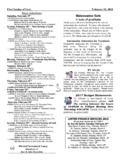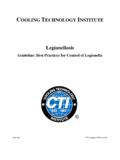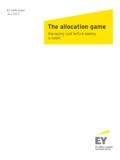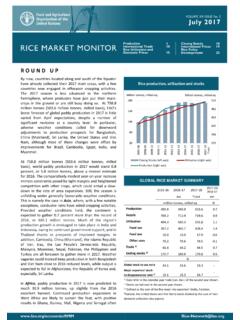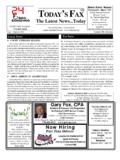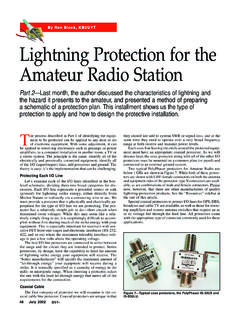Transcription of Applying IFRS - EY
1 Applying IFRS. IFRIC 21 Levies Accounting for Levies June 2014. Contents In this issue: 1. Introduction .. 3. 2. Scope of IFRIC 21 .. 3. 3. Recognition and measurement .. 8. Identification of the obligating event .. 8. Timing and measurement of liability 10. 4. Recognition of an asset or expense .. 12. 5. Interim reporting .. 14. 6. Effective date and 20. June 2014 - Accounting for Levies 1. What you need to know IFRIC 21 clarifies that an entity recognises a liability for a levy when the activity that triggers payment, as identified by the relevant legislation, occurs. The scope of this interpretation is very broad and captures various obligations, which are imposed by governments in accordance with legislation and sometimes not always described as levies.
2 ' Therefore, entities need to consider the nature of the payment carefully when determining if the payment is in the scope of IFRIC 21. A levy liability can only be accrued progressively if the activity that triggers payment occurs over a period of time, in accordance with the relevant legislation. For a levy that is triggered upon reaching a minimum threshold, the interpretation clarifies that no liability is recognised before the specified minimum threshold is reached. The interpretation does not address the accounting for the debit side of the transaction that arises from recognising a liability to pay a levy. Entities must look to other relevant standards to determine whether the recognition of a liability to pay a levy would give rise to an asset or an expense.
3 The interpretation is effective for annual periods beginning on or after 1 January 2014 and retrospectively applied for all prior periods presented. 2 June 2014 - Accounting for Levies 1. Introduction When governments or other public authorities impose levies on entities'. business activities, as opposed to income taxes and fines or other penalties, it is not always clear when the liability to pay a levy arises and should be recognised. In May 2013, the IFRS Interpretations Committee (IFRS IC or the Committee). issued IFRIC 21 Levies to address this issue. IFRIC 21 provides interpretative guidance on the accounting for levies based on the recognition criteria in IAS 37 Provisions, Contingent Liabilities and Contingent Assets.
4 The interpretation also indicates how these recognition criteria should be applied in an interim financial report prepared in accordance with IAS 34 Interim Financial Reporting. IFRIC 21 is effective for annual periods commencing on or after 1 January 2014 and is applied retrospectively, with early application permitted. In this publication, we address some of the frequently asked questions that arise as entities begin to apply IFRIC 21. The examples discussed herein assume that the effect of the time value of money is immaterial. This publication is not intended to provide a comprehensive list of IFRIC 21 issues and entities must consider all specific facts and circumstances when analysing any potential impacts.
5 This publication is based on the International Accounting Standards Board's (IASB) official pronouncements up to 30 April 2014; entities will need to consider any guidance published thereafter. 2. Scope of IFRIC 21. IFRIC 21 was developed to address concerns over the timing of recognition for When determining government-imposed levies in which the obligation to pay a government levy whether a payment is in depended on participation in a particular market on a specified date. However, the scope of IFRIC 21, it is the definition of levy in IFRIC 21 has resulted in the scope of the interpretation not the use of the term being broader than entities might have expected. levy', but the nature of the payment that should The term levy' may not be widely used across jurisdictions, and may be be considered.
6 Referred to as a charge, duty, tax, etc. However, it is not the terminology, but the nature of the payment, that should be considered when determining if it is in the scope of IFRIC 21. Entities need to be cautious about deciding to apply IFRIC 21 to an arrangement before conducting a thorough assessment of the specific facts and circumstances. Extract from IFRIC 21. 2 This Interpretation addresses the accounting for a liability to pay a levy if that liability is within the scope of IAS 37. It also addresses the accounting for a liability to pay a levy whose timing and amount is certain. 3 This Interpretation does not address the accounting for the costs that arise from recognising a liability to pay a levy.
7 Entities should apply other Standards to decide whether the recognition of a liability to pay a levy gives rise to an asset or an expense. 4 For the purposes of this Interpretation, a levy is an outflow of resources embodying economic benefits that is imposed by governments on entities in accordance with legislation ( laws and/or regulations), other than: (a) those outflows of resources that are within the scope of other Standards (such as income taxes that are within the scope of IAS 12. Income Taxes); and June 2014 - Accounting for Levies 3. Extract from IFRIC 21. (b) fines or other penalties that are imposed for breaches of the legislation. 'Government' refers to government, government agencies and similar bodies whether local, national or international.
8 5 A payment made by an entity for the acquisition of an asset, or for the rendering of services under a contractual agreement with a government, does not meet the definition of a levy. 6 An entity is not required to apply this Interpretation to liabilities that arise from emissions trading schemes. Entities should consider all payments imposed by governments pursuant to Consider all payments legislation ( , laws and/or regulations), to determine whether they are that are imposed by within the scope of IFRIC 21. The interpretation provides a broad definition of governments pursuant to government including, municipal, provincial, state, federal or international legislation.
9 Governments or government agencies or organisations controlled or administered by government. Sometimes, the legislation is not always clear about the nature of the payment and the activity that gives rise to the obligation. Therefore, legal opinions, past court rulings, and current practices may have to be examined to determine the appropriate accounting treatment that can require significant judgements, not only about whether the payment falls within the scope of IFRIC 21, but also (if in scope), when a liability should be recognised (see section 3 below). Payments for income taxes, fines and other penalties that are imposed for breaches of legislation, as well as costs relating to the acquisition of assets and contractual arrangements for services with a government are specifically excluded from the scope of IFRIC 21.
10 Additionally, application is not required for liabilities that arise from emission trading schemes. Different jurisdictions use different mechanisms to impose payments to governments. Consequently, each type of payment imposed by government needs to be evaluated on its own merits and according to the requirements of the local law. Questions which entities should consider in their assessment include: Is the payment within the scope of other IFRS standards1? Is the payment a fine or penalty imposed for breaches of the legislation? Is the payment for the acquisition of an asset, or for the rendering of services under a contractual agreement with a government2? If the answer is No' to all three questions above, then the payment is likely to be a levy within the scope of IFRIC 21.










